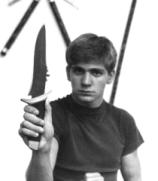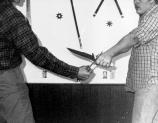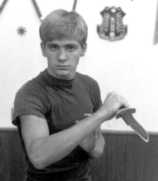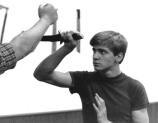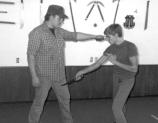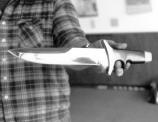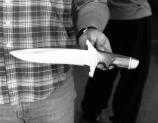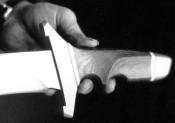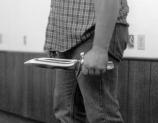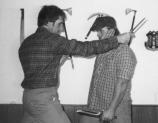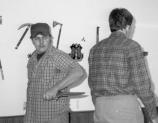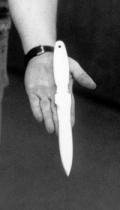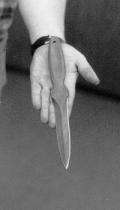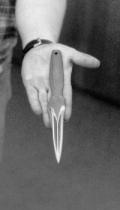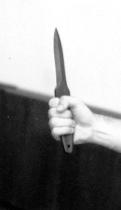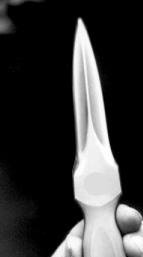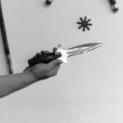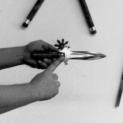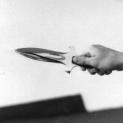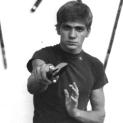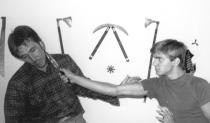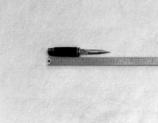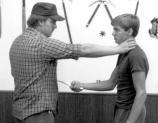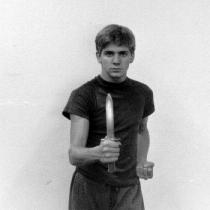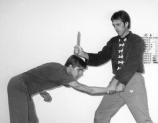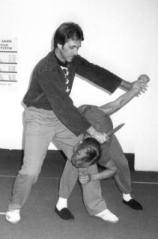
|
Design of the Modern Fighting Knife Introduction: After my article "How to
Survive a Knife Attack" appeared in the July/September
(1985) editions of Ta Originally, it was my intention to give the reader an overview of how the knife evolved as a tool and weapon. Moreover, I hoped to give the reader a firm grasp of two major influences in the design of the "modern" fighting knifes and to show, through use of examples, how these influences continue to manifest in virtually every notable fighting knife on the market. Origins of the Modern Fighting Knife: Experts generally agree the knife was one of the earliest, if not the very first, tool used by man. Throughout recorded history, it has been intimately linked with man in his struggle for survival against nature and the elements. When man first learned to shape stone, creating a stone cutting implement soon followed. The blade and the edge were crucial in preparing food, clothing, and even shelter. Most probably, the knife was a fundamental tool in day to day affairs long before its value in combat became established. So fundamental was the link to man, that with each passing state of development, stone, bronze, iron, steel, and alloy, the knife advanced to new levels of functionality as a tool, implement, and weapon. Even today, it is a natural part of our daily routine. It would be unusual for anyone to dispute they held knives in their hands at least five times any given day. There are a multitude of knives of various types and functions in every household, and at an early age, we understand the fundamental mechanics of using one safely and effectively. The knife fills several roles in modern lifestyles. These roles can be categorized as functional, life support, ceremonial, survival and self defense. In earliest times, the role of the knife was primarily survival and self defense. A knife was integral to one's ability to exist in a hostile environment, and in primitive societies, it was a valuable item indeed. The knife may have been the first true combat weapon, and paved the way for more sophisticated combat techniques when, with proper construction, it could be thrown effectively; or attached to a staff for use at a distance.
As the survival/self defense roles of the knife fall to specialized segments of our society, it remains top of the list in terms of its ubiquitous presence in modern day assaults and robberies. A cursory glance through any newspaper shows the number of assaults, attacks, robberies, and murders involving the knife far outstrips those involving other weapons. Hence, it is imperative a citizen of the modern world be able to react to the knife confrontation. In a previous article I presented an assortment of viable techniques. Here, we'll study the weapon. The Bowie Knife and the Dagger: The modern fighting knife traces its development to two classic knife designs, the Bowie knife, made famous by the American adventurer James Bowie; and the Dagger, resurrected by commandos during World War II, and influential ever since. The Bowie knife is a classic design by any standard. Conceived and refined in the 19th century, it climaxed the transition period form the long bladed weapon, or sword being the primary individual weapon, to the pistol. With the pistol, the sword met its quick and deserved demise, but the need remained for a well designed "close in" weapon for those situations where the pistol was no longer appropriate (such as when there wasn't ample time to reload the discharged pistol). The Bowie knife was ideal for the "gentleman" who had already been schooled in the use of the long blade or sword, and in many respects, it preserved enough characteristics of the sword to enable the expert swordsman to become a skilled knife fighter with minimal adjustment. Because of its breakthrough design, as well as the legend of the man whose name it bore, the Bowie was widely established and accepted by the time of the Civil War. Given modern theories of knife fighting, especially after the influx of innovative knife techniques from the Orient during recent years, the applicability of the Bowie knife has been called into question. Criticism has focused on the traditional single edge blade, the unwieldy weight distribution, and the difficulty employing a reverse hand grip with the traditional design. Valid as these points are, the bottom line is that even with the detractors, world class knife fighters continue to swear by the Bowie knife, and it's here to stay.
Today, virtually all knives are patterned after the Bowie or the Dagger, or attempt to capitalize on the advantages of each design in a "combined" concept. In the following paragraphs, I intend to demonstrate the influence of these designs in fighting knives being produced today, afterwhich I will conclude with those elements of design which I feel are essential in my personal choice for an "ideal" fighting knife. The Bowie Influence The SAS (Special Air Services): The SAS nicely demonstrates the "highlights" inherent in the Bowie Design. Visible on first glance are the Bowie "look," demonstrating the unique proportion between handle and blade, the ever present hand guard, and the classic Bowie blade, which can run up to 12 inches in length in a modern knife. The SAS, while preserving the integral concept, has incorporated some significant modifications to circumvent the inherent weaknesses of the traditional design.
The Rezin Bowie:
The Rezin Bowie demonstrates the traditional Bowie "size." Looking at this particular version, it is easy to understand why a "gentleman" trained in the sword, found it an easy transition to adapt to the Bowie. The Rezin Bowie also incorporates some modern concepts as offsets to weaknesses in the traditional design. The handle presents a "tailored" grip, thereby form fitting the knife to the shape of the owner's hand, enabling him to more efficiently control and maneuver the blade in a fight. Also the blade presents a more symmetrical look than the traditional design, which in conjunction with the sharpened edge, almost gives the weapon the appearance of an overgrown dagger. The Combat Survivor:
This descendant of the Bowie concept is notable for its enhanced hand guard, and a tailored handle grip. As the accompanying photographs show, the careful design of the handgrip and hand guard allow for maximum combat efficiency even when using a reverse grip with the unique design.
The Dagger Influence The Raider:
The Raider II:
Modern Concepts Though it is difficult to find any modern knife design that drifts far from the influence of either the Bowie or the Dagger, it is nonetheless true to state that modern knife makers are forever searching for that ultimate combination of design and technology leading to the yet undiscovered perfect design. Currently two major trends are evident in the trade. First, as was clear throughout this article, knife makers continue to study, research, and refine the classical Bowie/Dagger designs, gradually weaning away drawbacks inherent in the traditional concepts, and attempting to incorporate the best features into hybrid designs for the future. Second, some designers are evolving entirely new approaches, based upon careful study of the anatomy and modern breakthroughs in knife fighting tactics. Below, we will look at two examples which epitomize the current trends in knife design.
Aptly demonstrating efforts of the modern knife maker to amalgamate fine points of the Bowie to the Dagger in a modern design is the Kopf Jager. This is a classic design in its own right, melding the two philosophies into a perfectly functional, versatile unit. Immediately apparent is the traditional Bowie handguard, modified to accommodate varied handgrips. Note the thumb notch carved into the custom handle, and how the rear contour of the hand guard allows for comfortable placement of the thumb so that maximum thrust/slash penetration is comfortable with virtually any grip. The graceful taper of the blade into the turnaway hand guard opens up new strategic avenues for effective use of the handguard in defending and exploding into quick counters. Lastly, a further study of this unique blade reflects the Bowie influence in its design, and the Dagger influence in its balance and symmetry. This is truly a weapon for the experienced fighter, and seeing one in the hands of an opponent should certainly signal the defender that a difficult confrontation lay ahead.
The Devil's Spike:
Proving that modern knife makers still have plenty of creative juices is the Devil's Spike. It is safe to say that this weapon stands alone, and comes from a different family tree than either the Bowie or the Dagger. The three edged blade with its cutaway spoon base is a surgeon's nightmare, producing wounds to internal organs that are painstakingly difficult to close, if not impossible. This weapon is for the consummate specialist who routinely goes for targets on the trunk of the body, and has perfected his attacks to hit designated areas virtually at will. Equally as extraordinary as the futuristic blade is the wide bodied handle, with carved thumb notch. This design greatly enhances leverage and penetration for the fighter who favors powerful thrusts into his opponent's vital organs. Searching for the Ideal
Once, after a seminar, a gentleman by the name of Roy Kauffroath from Bremerton, Washington (eventually we became lifelong friends) asked me what I felt were the ideal features of a fighting knife. Essentially, I responded with the same comments as above. To my surprise and delight, when I next encountered Mr. Kauffroath, he presented me with a practice weapon, custom made to my specifications. So, thanks to Mr. Kauffroath, we have the accompanying photographs of the "Kauffroath," or what I feel to be the ideal design for my personal fighting style. Conclusion In researching this article, I was astonished at the dedication, expertise, and creativity brought by modern knife makers to their art. Meeting with them brought to mind images of medieval Japanese craftsmen bringing generations of knowledge to bear in creating bladed weapons which have become standards for all time. Until meeting the modern craftsmen, I never anticipated the same "impeccable" attitude would be found today, and was delighted to learn it was prevalent among this unique guild.
In the course of this article, we have presented the major influences in current knife design, and have demonstrated these influences with numerous examples. You are well on the road toward being able to "read" your opponent. The rest is up to you! In closing, I must acknowledge a special debt of gratitude to Paul Inman, Brad Dugan, and Joe Karreci of Pacific Northwest Gun and Knife, Ltd. Without their generous gift of time and their help in collecting the sample weapons described herein, this article would not have been possible. Author's Note: This article was originally written in 1985, but holds true today. Pacific Northwest Gun and Knife, Ltd. eventually shut down with Paul Inman, Brad Dugan, and Joe Karreci continuing their pursuits elsewhere. Their creations, some of which are shown in this article, were among the finest specimens of fighting weapons I have ever seen. |
[Home] [About Us
] [Archie] [Concepts] [Contact Us]
[Gun
Fu Manual] [Kata]
[Philosophy] [Sticks] [Stories] [Web
Store] [Terms of Use]
[Video]
Copyright 2000-2025, Mc Cabe and Associates, Tacoma, WA. All rights reserved. No part of this site can be used, published, copied or sold for any purpose, except as per Terms of Use .
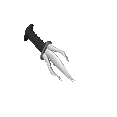 As combat techniques advanced, distancing
from the opponent became more important and the greater
the distance, the better. Weapons evolved from the club
to the spear, to the bow, and then to the gun. With each
technological advance, the self defense role of the
knife diminished. Prior to the arrival of the 19th
century, blade training was an essential part of a
gentleman's education. Today's combat strategies have so
reduced the possibility of ever having to face an enemy
in hand to hand combat, that even in the modern
military, knife training is reserved only for those
select few whose training in areas of subterfuge require
it. Nonetheless, the knife has never lost its identity
as a weapon, and for many, it remains the weapon of
choice in close combat.
As combat techniques advanced, distancing
from the opponent became more important and the greater
the distance, the better. Weapons evolved from the club
to the spear, to the bow, and then to the gun. With each
technological advance, the self defense role of the
knife diminished. Prior to the arrival of the 19th
century, blade training was an essential part of a
gentleman's education. Today's combat strategies have so
reduced the possibility of ever having to face an enemy
in hand to hand combat, that even in the modern
military, knife training is reserved only for those
select few whose training in areas of subterfuge require
it. Nonetheless, the knife has never lost its identity
as a weapon, and for many, it remains the weapon of
choice in close combat.